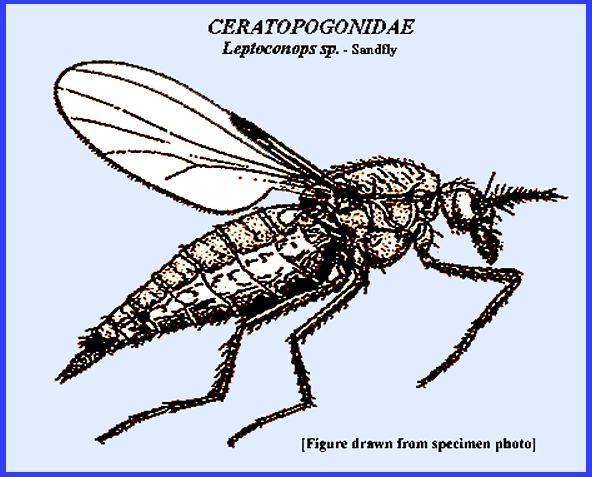File: <ceratopogonidaekey.htm> <Medical Index> <General Index> Site Description Glossary <Navigate to Home>
|
Insecta: Diptera Key
To The Genera of CERATOPOGONIDAE (Biting Midges, Punkies) (Contact) Please CLICK on picture and
underlined links to view or to navigate within the key: To Search for Subject
Matter use Ctrl/F Of the over 5,500
species and 104 genera of Ceratopogonidae there are only four genera that
attack vertebrates (Leptoconops,
Lasiohelea,
Holoconops
& Culicoides). However, of these four only Leptoconops and Culicoides are of medical importance to
humans, primarily because of their annoying biting habits, which can trigger
an allergic response of skin swelling and severe itching. The transmission of filarial worms by some
species is confined to the African continent. Members of this family
are distinguished by a long antenna and short proboscis (Fig 1). Also, the wing membrane bears an array of
tiny hairs (macrotrichia).
Ornamentation with dark and pale areas is common. The following key
separates the four important genera:
_ _ _ _ _ _ _ _ _ _ _ _ _ _
_ _ _ _ _ _ Key References: <medvet.ref.htm> <Hexapoda> Blanton, F. S. & W. W. Wirth. 1979. The sand flies (Culicoides) of Florida
(Ceratopogonidae). Arthropods of Florida and Neighboring Land Areas
Volume 10. Florida Department of Agriculture and Consumer Services. Borkent,
A. & W. W. Wirth. 1997. World species
of biting midges (Diptera: Ceratopogonidae). Bull. American Museum of Natural
History 233: 1–257. Clastrier, J. & W. W. Wirth. 1978. The Leptoconops
kerteszi complex in North America (Diptera: Ceratopogonidae).
United States Department
of Agriculture Technical
Bulletin Number 1573 Downes, J. A. & W. W. Wirth. 1981. Chapter 28: Ceratopogonidae. Pp.
393–421. In: McAlpine, J.F.,
B.V. Peterson, G.E. Shewell, H.J. Teskey,
J.R. Vockeroth, and D.M. Wood.
Manual of Nearctic Diptera, Volume 1. Agriculture Canada Monograph 27. Hendry, G. 2003. Midges in Scotland 4th Edition, Mercat
Press, Edinburgh. Jobling, B. 1928.
The structure of the head and the mouth parts of Culicoides pulicaris L. Bull. Ent. Res.
18: 211-36 Kettle, D. S. 1965.
Biting certatopogonids as vectors of human and animal diseases. Acta Trop. 22: 356-62. Kettle, D. S. 1969.
The ecology and control of blood-sucking ceratopogonids. Ann. Rev. Ent. 22: 33-51. Legner,
E. F. 1995. Biological control
of Diptera of medical and veterinary importance. J. Vector Ecology 20(1): 59-120. Legner, E. F.. 2000.
Biological control of aquatic Diptera. p. 847-870.
Contributions to a Manual of Palaearctic Diptera, Vol. 1, Science Herald, Budapest. 978 p Legner,
E. F., R. D. Sjogren & J. T. Wiles.
1970. Effects of low biuret
urea on natural populations of Hippelates
collusor (Townsend) and Leptoconops kerteszi (Kieffer). J. Amer. Mosq. Contr.
Assoc. 30(4): 634-640. 71. Legner,
E. F., R. D. Sjogren & L. L. Luna.
1980. Arthropod
fauna cohabiting larval breeding sites of Leptoconops
foulki Clastrier & Wirth in the Santa Ana River, California. J. Amer. Mosq. Contr. Assoc. 40(1): 46-54.
192. Linley,
J. R., A. L. Hoch & F. P. Pinheiro.
1983. Biting
midges (Diptera: Ceratopogonidae) and human health. J. Med. Ent. 20:
347-64. Mullen, G. R. and L.J. Hribar. 1988.
Biology and feeding behavior of ceratopogonid larvae (Diptera:
Ceratopogonidae) in North America. Bulletin of the Society for Vector
Ecology 13: 60–81. Mullens,
B. A. and R. K. Velten. 1994. Rearing Culicoides
variipennis (Diptera: Ceratopogonidae) on agar and nematodes. J. Med. Ent. 31:
175- 177. Mullens,
B. A. and R. K. Velten. 1994. Laboratory culture and life
history of Heleidomermis magnapapula
in its host, Culicoides variipennis
(Diptera: Ceratopogonidae).
J. Nematol. 26: 1-10. Matheson, R. 1950. Medical Entomology. Comstock Publ. Co, Inc. 610 p. Paine, E. O. and B. A.
Mullens. 1994. Distribution, seasonal occurrence, and patterns of parasitism
of Heleidomermis magnapapula (Nematoda: Mermithidae), a parasite of Culicoides variipennis (Diptera:
Ceratopogonidae) in California. Environ. Entomol. 23: 154-160. Service, M. 2008. Medical Entomology For Students. Cambridge Univ. Press. 289 p Wirth, W. W. & F. S. Blanton. 1974. The West Indian
sandflies of the genus Culicoides
(Diptera: Ceratopogonidae). United States Department of Agriculture Technical Bulletin
Number 1474. Wirth, W. W. &
W. L. Grogan, Jr. 1988. The Predaceous Midges of the World (Diptera:
Ceratopogonidae; Tribe Ceratopogonini). Flora and Fauna Handbook Number 4. E.J. Brill Publishers, Leiden. xv + 160 pp. |
